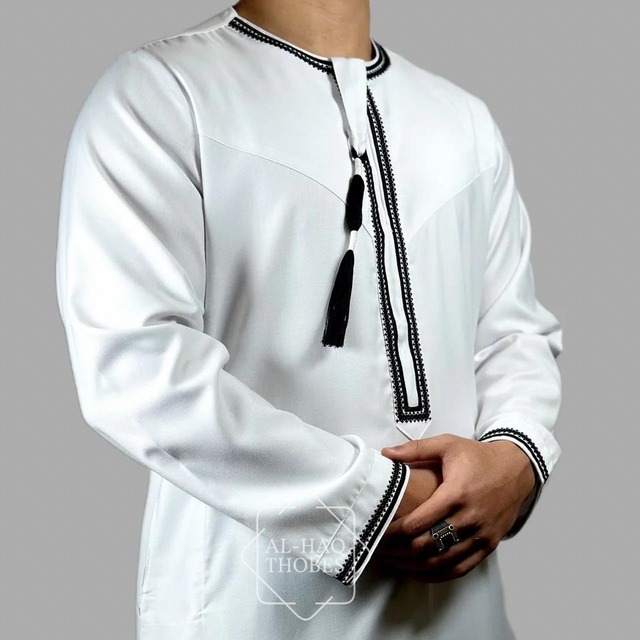Thobes, also known as thawbs, dishdashas, or kanduras, are traditional garments worn by men primarily in the Arab world and some Muslim communities globally. These garments are characterized by their long, flowing design that extends to the ankles, offering a blend of cultural heritage, modesty, and comfort. This comprehensive overview delves into the history, design variations, cultural significance, and modern adaptations of the thobe.
Historical Background
Origins and Evolution
The thobe's origins can be traced back to the Arabian Peninsula, where it has been worn for centuries. Historically, the thobe was designed to suit the harsh desert climate, providing protection from the sun and allowing air to circulate freely. Over time, the garment evolved, influenced by different cultures and regions, leading to a variety of styles and adaptations.
Traditional Uses
Traditionally, thobes for men were worn for everyday activities as well as special occasions. They were and still are an essential part of a man’s wardrobe in many Middle Eastern countries, serving both practical and symbolic purposes. The simplicity and elegance of the thobe made it suitable for all social classes, from laborers to royalty.
Design and Variations
Basic Structure
A typical thobe is a long robe with a loose fit, featuring long sleeves and a round neckline. The length generally reaches the ankles, although variations in length can be found depending on regional styles and personal preferences. Thobes are usually made from lightweight materials such as cotton or linen to suit the warm climates where they are most commonly worn.
Regional Styles
Saudi Thobe
The Saudi thobe, known for its formal and elegant design, often features intricate embroidery around the neckline and cuffs. This style is typically worn in Saudi Arabia and is made from high-quality fabrics.
Emirati Kandura
The kandura, worn in the United Arab Emirates, is similar to the Saudi thobe but tends to have a simpler design with less embroidery. It often includes a tassel (tarboosh) attached to the neckline, adding a distinctive touch.
Qatari Thobe
Qatari thobes are known for their tailored fit and luxurious fabrics. They often feature a shirt collar and are worn with a headscarf (ghutra) and an agal, a black cord used to secure the ghutra.
Omani Dishdasha
The Omani dishdasha is unique for its colorful tassel, called a "furakha," hanging from the neckline. This style is typically made from slightly thicker fabric to accommodate the cooler mountain climates in Oman.
Cultural Significance
Symbol of Identity
The thobe serves as a significant cultural symbol, representing Arab and Muslim identity. Wearing a thobe is often a declaration of cultural pride and a means of preserving tradition in a rapidly modernizing world.
Religious Connotations
In many Islamic communities, the thobe is also associated with religious piety and modesty. The garment's loose fit adheres to Islamic principles of modest dress for men, and it is often worn during religious observances and prayers.
Social Status
While the thobe itself is a garment for all, variations in fabric quality, embroidery, and accessories can indicate social status and wealth. High-ranking officials and affluent individuals might wear thobes made from luxurious materials like silk or adorned with gold embroidery.
Modern Adaptations
Contemporary Fashion
In recent years, thobes have seen a resurgence in popularity as fashion designers incorporate modern elements into traditional designs. This includes experimenting with different fabrics, colors, and cuts while maintaining the garment’s essential characteristics.
Western Influence
The influence of Western fashion has also led to hybrid styles, where traditional thobe elements are blended with Western clothing. For instance, you might see a thobe paired with a blazer or styled with contemporary accessories.
Global Popularity
Beyond the Arab world, the thobe has gained popularity in various Muslim communities globally. It is often worn during religious festivals like Eid or significant life events such as weddings, symbolizing a connection to cultural and religious roots.
Practical Considerations
Climate Adaptability
One of the thobe's primary advantages is its adaptability to hot climates. The loose, flowing design allows for air circulation, helping to keep the wearer cool. Materials like cotton and linen are preferred for their breathability.
Maintenance and Durability
Thobes are generally easy to maintain. They are typically machine washable, and high-quality fabrics can withstand frequent use. However, intricate embroidery may require more delicate care.
Comfort and Versatility
The thobe's design offers unparalleled comfort and versatility. It can be worn casually for everyday activities or dressed up for formal occasions. The loose fit makes it an ideal garment for long wear, providing ease of movement.
How to Wear a Thobe
Traditional Accessories
Headgear
Headgear is an essential part of the traditional look. The ghutra (headscarf) and agal (black cord) are commonly worn in the Gulf region, while the keffiyeh is popular in the Levant. These accessories not only complement the thobe but also serve practical purposes like protection from the sun.
Footwear
Sandals or traditional leather shoes are typically worn with thobes. In formal settings, more polished footwear may be chosen to match the occasion.
Modern Styling Tips
To modernize the thobe, some men opt for layering with jackets or incorporating contemporary accessories like watches or sunglasses. Choosing thobes in different colors and fabrics can also provide a modern twist while maintaining the garment’s traditional essence.
Conclusion
The thobe remains a timeless garment that blends tradition, culture, and modernity. Its enduring popularity in the Arab world and beyond is a testament to its versatility, comfort, and cultural significance. Whether worn for everyday activities or special occasions, the thobe continues to be a symbol of identity and heritage, adapting to the changing fashion landscape while preserving its roots. Visit the official website of al-haqthobes.com

